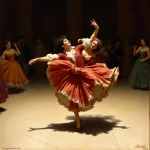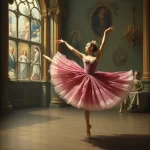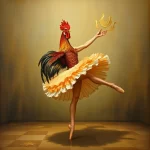Ballet: Les Mariés de la tour Eiffel (Georges Auric, 1921)

Introduction
Ballet, as an art form, has always been a medium for storytelling through the graceful movements of dancers and the evocative power of music. One such ballet that stands out in the annals of dance history is Les Mariés de la tour Eiffel, composed by Georges Auric in 1921. This ballet, choreographed by Jean Börlin, premiered on June 18, 1921, and is a fascinating blend of surrealism and modernism. The ballet’s plot revolves around a wedding party at the Eiffel Tower, where a series of bizarre and whimsical events unfold, reflecting the avant-garde spirit of the early 20th century.
Historical Background
Creation and Development
The early 1920s were a period of significant artistic experimentation and innovation. The aftermath of World War I saw a surge in avant-garde movements, including surrealism and modernism, which sought to break away from traditional forms and explore new artistic expressions. Les Mariés de la tour Eiffel was born out of this context, drawing inspiration from the surrealist movement and the burgeoning modernist aesthetic.
The ballet was inspired by a literary source, specifically a poem by Jean Cocteau, who was a central figure in the Parisian avant-garde scene. Cocteau’s collaboration with Georges Auric, a member of the group of composers known as “Les Six,” and choreographer Jean Börlin, resulted in a unique and innovative ballet that combined music, dance, and surrealist imagery.
Premiere and Reception
Les Mariés de la tour Eiffel premiered on June 18, 1921, at the Théâtre des Champs-Élysées in Paris. The initial reception was mixed, with some critics praising its originality and others finding it too unconventional. However, the ballet quickly gained a reputation for its bold and innovative approach, leading to several notable early performances and revivals.
Synopsis of the Ballet
Les Mariés de la tour Eiffel is a one-act ballet that unfolds in a series of surreal and whimsical scenes. The plot centers around a wedding party at the Eiffel Tower, where a series of bizarre events take place, blending humor, fantasy, and absurdity.
Key Moments
- The wedding ceremony: The ballet opens with a wedding ceremony at the Eiffel Tower, setting the stage for the ensuing surreal events.
- The appearance of strange characters: Various eccentric characters, including a photographer, a lion, and a giant baby, make unexpected appearances, adding to the whimsical atmosphere.
- The dance of the Eiffel Tower: In a surreal twist, the Eiffel Tower itself comes to life and performs a dance, symbolizing the blending of reality and fantasy.
- The conclusion: The ballet ends with the wedding party continuing their celebration, leaving the audience with a sense of wonder and amusement.
Musical Composition
Composer’s Role
Georges Auric, a prominent member of “Les Six,” composed the music for Les Mariés de la tour Eiffel. Auric’s contribution to the ballet was significant, as his score captured the whimsical and surreal nature of the narrative. The music is characterized by its playful melodies, unexpected harmonies, and rhythmic inventiveness, which complement the ballet’s avant-garde choreography.
Musical Themes and Motifs
The score of Les Mariés de la tour Eiffel features several recurring musical themes and motifs that enhance the narrative and emotional impact of the ballet. For example, the playful and light-hearted theme associated with the wedding ceremony contrasts with the more mysterious and eerie motifs that accompany the appearance of strange characters. Auric’s use of leitmotifs helps to create a cohesive musical structure that mirrors the ballet’s surreal and whimsical atmosphere.
Famous Recordings and Performances
Over the years, there have been several notable recordings and performances of the music from Les Mariés de la tour Eiffel. One of the most iconic recordings is conducted by Jean Martinon with the Orchestre National de l’ORTF, which captures the essence of Auric’s playful and inventive score. Additionally, various ballet companies have performed the ballet, each bringing their unique interpretation to the music and choreography.
Choreography and Dance
Choreographer’s Vision
Jean Börlin, the choreographer of Les Mariés de la tour Eiffel, was known for his innovative and avant-garde approach to dance. Börlin’s vision for the ballet was to create a surreal and whimsical world that defied traditional narrative structures. His choreography incorporated elements of modern dance, mime, and acrobatics, reflecting the influence of the surrealist movement.
Signature Dance Numbers
One of the key dance numbers in the ballet is the “Dance of the Eiffel Tower,” where the iconic Parisian landmark comes to life and performs a whimsical dance. This scene is a highlight of the ballet, showcasing Börlin’s inventive choreography and the surreal nature of the narrative. Another notable dance number is the “Wedding Dance,” which features playful and light-hearted movements that capture the celebratory atmosphere of the wedding party.
Notable Interpretations
Over the years, various productions of Les Mariés de la tour Eiffel have interpreted and adapted Börlin’s choreography in different ways. Some productions have emphasized the surreal and whimsical aspects of the ballet, while others have focused on the modernist elements. Notable interpretations include those by the Ballets Suédois, who originally performed the ballet, and more recent productions by contemporary ballet companies.
Characters and Roles
Main Characters
- The Bride and Groom: The central characters of the ballet, whose wedding at the Eiffel Tower sets the stage for the surreal events that follow.
- The Photographer: A whimsical character who captures the wedding party’s moments and adds to the surreal atmosphere.
- The Lion: An unexpected guest at the wedding, symbolizing the blending of reality and fantasy.
- The Giant Baby: Another surreal character who adds to the whimsical and absurd nature of the ballet.
Supporting Characters
- The Wedding Guests: A group of eccentric characters who participate in the wedding celebration and contribute to the ballet’s whimsical atmosphere.
- The Eiffel Tower: A unique character that comes to life and performs a dance, symbolizing the surreal nature of the narrative.
Famous Dancers
Several notable dancers have portrayed the roles in Les Mariés de la tour Eiffel over the years. Jean Börlin himself performed in the original production, bringing his unique style and vision to the ballet. Other famous dancers who have taken on these roles include members of the Ballets Suédois and contemporary ballet companies who have revived the ballet in recent years.
Cultural and Artistic Impact
Influence on Ballet and Dance
Les Mariés de la tour Eiffel has had a significant influence on the world of ballet and dance. Its innovative choreography and surreal narrative broke away from traditional forms and paved the way for future avant-garde works. The ballet’s blending of modern dance, mime, and acrobatics has inspired choreographers and dancers to explore new artistic expressions and push the boundaries of the art form.
Cultural Significance
The ballet’s place in popular culture is also noteworthy. Its surreal and whimsical nature has made it a subject of interest in literature, theater, and other media. The ballet has been referenced in various artistic works and has inspired adaptations in film and theater, further cementing its cultural significance.
Legacy and Revivals
Les Mariés de la tour Eiffel continues to be performed and celebrated today, with major revivals and reinterpretations by contemporary ballet companies. These modern adaptations often bring new perspectives to the ballet, highlighting its timeless appeal and relevance. The ballet’s legacy is evident in its enduring popularity and its influence on the development of ballet as an art form.
Iconic Productions
Historic Productions
The original production of Les Mariés de la tour Eiffel by the Ballets Suédois is one of the most famous historical productions. Directed by Rolf de Maré and featuring choreography by Jean Börlin, this production set the standard for future performances. The set design, costumes, and lighting were all carefully crafted to enhance the surreal and whimsical atmosphere of the ballet.
Contemporary Productions
Recent productions of Les Mariés de la tour Eiffel have brought new interpretations and innovations to the ballet. Contemporary ballet companies have explored different aspects of the narrative and choreography, often incorporating modern dance techniques and multimedia elements. These productions highlight the ballet’s enduring appeal and its ability to resonate with modern audiences.
Production Design
The set, costume, and lighting design in various productions of Les Mariés de la tour Eiffel have played a crucial role in creating the ballet’s surreal and whimsical atmosphere. The original production featured innovative set designs by Fernand Léger, which included abstract and geometric shapes that complemented the modernist aesthetic. Costume designs by Jean Cocteau and others added to the visual appeal, while creative lighting techniques enhanced the overall experience.
Critical Reception and Reviews
Initial Critical Response
The initial critical response to Les Mariés de la tour Eiffel was mixed. Some critics praised its originality and innovative approach, while others found it too unconventional and difficult to understand. However, the ballet quickly gained a reputation for its bold and avant-garde style, leading to several notable early performances and revivals.
Modern Reviews
Contemporary critics and audiences have generally been more appreciative of Les Mariés de la tour Eiffel, recognizing its significance in the history of ballet and its influence on modern dance. The ballet’s surreal and whimsical nature continues to captivate audiences, and its innovative choreography and music are often highlighted in reviews. The ballet remains relevant today, as it challenges traditional forms and encourages artistic experimentation.
Fun Facts and Trivia
Behind-the-Scenes Stories
One interesting behind-the-scenes story involves the collaboration between Jean Cocteau and Georges Auric. Cocteau’s surrealist vision and Auric’s inventive music created a unique synergy that brought the ballet to life. Their collaboration extended beyond Les Mariés de la tour Eiffel, as they continued to work together on various artistic projects.
Notable Performers
Several famous dancers, conductors, and directors have been associated with Les Mariés de la tour Eiffel over the years. Jean Börlin, who choreographed and performed in the original production, is one of the most notable figures. Other famous performers include members of the Ballets Suédois and contemporary ballet companies who have revived the ballet in recent years.
Trivia
- The ballet’s title, Les Mariés de la tour Eiffel, translates to “The Wedding Party on the Eiffel Tower,” reflecting its whimsical and surreal nature.
- The original production featured set designs by Fernand Léger, a prominent modernist artist known for his abstract and geometric works.
- The ballet’s music was composed by Georges Auric, a member of “Les Six,” a group of French composers known for their innovative and avant-garde approach to music.
Conclusion
Summary of the Ballet’s Importance
Les Mariés de la tour Eiffel is a significant work in the world of ballet, known for its innovative choreography, surreal narrative, and inventive music. The ballet’s blending of modern dance, mime, and acrobatics broke away from traditional forms and paved the way for future avant-garde works. Its influence on ballet and dance is evident in its enduring popularity and its impact on contemporary choreographers and dancers.
Final Thoughts
Reflecting on Les Mariés de la tour Eiffel, it is clear that this ballet remains a timeless and relevant work of art. Its surreal and whimsical nature continues to captivate audiences, while its innovative choreography and music inspire new generations of artists. For those who have not yet experienced this unique ballet, it is highly recommended to watch a performance or listen to the score to fully appreciate its artistic brilliance.
FAQ
What is the central theme of this ballet?
The central theme of Les Mariés de la tour Eiffel is a whimsical and surreal wedding party at the Eiffel Tower, where a series of bizarre and fantastical events unfold.
Who are the main characters in this ballet?
The main characters include the Bride and Groom, the Photographer, the Lion, and the Giant Baby, each contributing to the surreal and whimsical atmosphere of the ballet.
What is the most famous dance number in this ballet?
One of the most famous dance numbers is the “Dance of the Eiffel Tower,” where the iconic landmark comes to life and performs a whimsical dance.
How long does a typical performance of this ballet last?
A typical performance of Les Mariés de la tour Eiffel lasts approximately 30 to 40 minutes, as it is a one-act ballet.
Are there any modern adaptations of this ballet?
Yes, there have been several modern adaptations and revivals of Les Mariés de la tour Eiffel by contemporary ballet companies, each bringing new interpretations and innovations to the ballet.
Why is this ballet considered important in the history of dance?
Les Mariés de la tour Eiffel is considered important in the history of dance due to its innovative choreography, surreal narrative, and inventive music. It broke away from traditional forms and paved the way for future avant-garde works, influencing choreographers and dancers to explore new artistic expressions.





